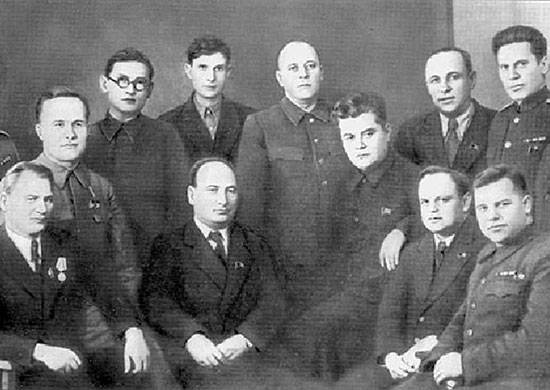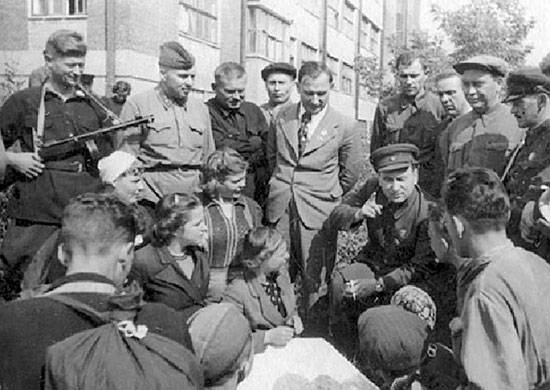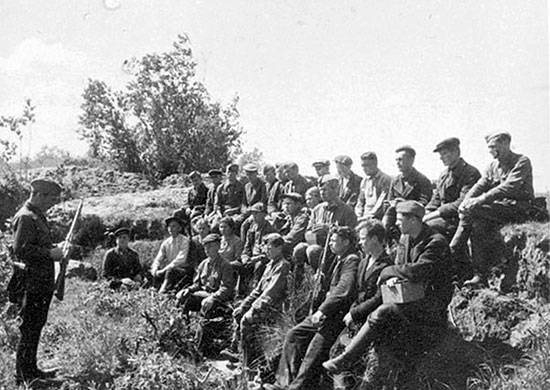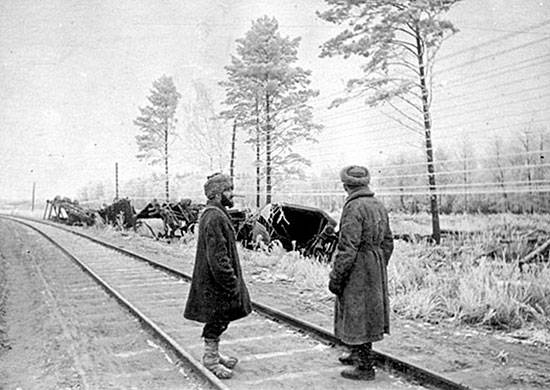The central body of the military control of the guerrilla movement at the Headquarters of the Supreme Command during the Great Patriotic War

The leaders of the partisan movement of the republics, territories, regions in the occupied territory of the USSR. From left to right: sit - D.M. Popov, V.G. Zhavoronkov, PK Ponomarenko, I.P. Boytsov, B.N. Chernousov, A.P. Matveyev; stand - A.K. Sprogis, V.S. Bulatov, M.A. Suslov, P.I. Seleznev, N.L. Sologor, S.Ya. Vershinin, A.Yu. Snackus
From the very beginning of the Great Patriotic War, the leadership of the partisan movement did not have sufficient symmetry and organization. This issue was dealt with by various bodies, as a rule, without the necessary coordination of efforts, which adversely affected the deployment of popular struggle in the rear of the German troops. In the first months of the war, the guerrilla movement was led by such departments as the Central Committee of the Communist Parties of the Republics and the Regional Committees of the CPSU (B.); Chief Political Department of the Red Army; the fourth department of the People's Commissariat of Internal Affairs (NKVD), the military councils of the fronts and armies, the intelligence agencies of the fronts and the army.
Unfortunately, this led to inconsistency and parallelism in the work, poor-quality expenditure of forces and means, and sometimes to the victims, since all these management structures most often set tasks for the same partisan detachments without sufficient coordination of efforts between themselves.
30 May 1942 issued a decree of the State Defense Committee on the creation of a partisan movement at the Headquarters of the Supreme Command. Its head was a prominent state and political figure of the country, the first secretary of the Central Committee of the Communist Party (Bolsheviks) of Belarus, P.K. Ponomarenko. For the direct leadership of the partisan formations under the military councils of the fronts, the same decree formed the Ukrainian (under the Military Council of the Southwestern Direction), Bryansk, Western, Kalininsky, Leningrad and Karelian-Finnish (under the Military Council of the Karelian Front) headquarters of the partisan movement (BBA) who submitted to the central headquarters of the partisan movement. At the beginning of its operation, three persons belonged to the TSPPH: in addition to Ponomarenko, it was V.T. Sergienko (from the NKVD) and Colonel T.F. Korneyev (from the Intelligence Directorate of the People's Commissariat of Defense).
With the establishment of 6 in September 1942, the post of Commander-in-Chief of the guerrilla movement Marshal of the Soviet Union K.Ye. Voroshilov TSSHPD obeyed him. After the abolition of the post of Commander-in-Chief of 19 in November 1942, the CSPD re-acted as the organ of the Supreme Command Headquarters. In the subordination of the CSPD were republican and regional (front) headquarters of the partisan movement (BBA).

Head of Central Broadband PK Ponomarenko with Belarusian partisans. Moscow, September 17 1942
The goals and objectives of the partisan struggle during the war years were determined on the basis of the common military-political goals of the armed struggle of the Soviet people against Hitler Germany and its allies. The main goal of the partisan struggle behind enemy lines was to assist the Red Army in defeating the German fascist troops and liberating the occupied territory.
The general tasks for the development of guerrilla warfare are reflected in the decisions of the government and the Central Committee of the party, in the decrees of the State Defense Committee, in the orders of the People's Commissar of Defense and the Supreme Command General Headquarters.
The main tasks of the partisan struggle were:
1. The destruction of manpower, military equipment and material means of the enemy;
2. Disorganization of the work of transport and communications in the occupied territory (undermining bridges, damage to railways, the organization of train derailments, an attack on the automobile and horse-drawn transport of the enemy);
3. The defeat of the military garrisons of the enemy, the liberation and retention of Soviet territory in the rear of the German fascist troops;
4. Conducting intelligence reconnaissance of the enemy in the interests of the Soviet Armed Forces;
5. Capturing and holding up to the approach of the Soviet troops frontiers, crossings and sections convenient for forcing water obstacles, etc.
During the Great Patriotic War 1941 – 1945. The central and regional headquarters of the partisan movement in the organization and deployment of popular struggle in the Soviet regions captured by the enemy had to solve a number of large and complex problems. First of all, they include: the search for the most appropriate organizational forms of partisan forces; guerrilla training; the problem of the logistics of the partisans; the choice of the most effective forms and methods of guerrilla warfare; the problem of planning and organizing the interaction of partisan forces with regular troops, etc.
One of the important problems that PK had to solve. Ponomarenko, both the head of the Center for Protective Labor and Social Development, and the heads of regional broadband services, was the problem of choosing the most appropriate organizational forms. The weak development of the theoretical questions of the partisan movement before the war led to the fact that the search for the most acceptable organizational forms of the partisan forces had to be carried out directly in the course of the hostilities unfolded.
The best organizational unit, as practice has shown, has become a partisan detachment. Its structure was determined by the number of personnel, the number and composition of weapons, the conditions of the area in which the detachment operated, and the nature of the tasks performed. The size of the squadron at the beginning of the war was 20 – 70, and then to 200 and more.
It should be emphasized that the detachment form of organization of partisan forces fully paid off. The actions of a large number of partisan groups and detachments in vast territories deprived the enemy of his advantages in strength and equipment. In rugged wooded areas, he was not able to effectively use artillery against partisans, Tanks и Aviation. It was difficult for the enemy to detect and pursue partisans who knew their areas well and relied on the support of the population. Mobile partisan units could attack the enemy suddenly, in a timely manner, leave the battle or evade it.
However, a large number of disparate partisan detachments and groups were very difficult to manage. Their actions were very difficult to coordinate even when solving simple tasks, not to mention the conduct of large-scale operations according to a single plan. That is why, with an increase in the scope of the partisan movement, larger formations appeared, for example, such as partisan units. Their names were different, popular creativity of the masses affected: separate active partisan regiments, brigades, formations, partisan-rifle divisions. The most typical was the unification of individual partisan detachments into brigades, whose numbers ranged from a few hundred to 3 – 4 and more than a thousand people. During the war years, attempts were made to create larger partisan units. So, at the end of August, 1942, the Kalininsky Broadband Internet, united seven partisan brigades into the 1 of the Kalinin Partisan Corps. In September, the corps, numbering in 3 thousand, began a raid on the enemy’s rear. However, a month later, after completing the assigned tasks and due to the great logistical support, the corps was disbanded.

School training guerrilla personnel (school saboteurs). School Commissioner Senior Politruk GS Radyuk conducts classes on the material part of the rifle. Kalininsky Front, D. Schein. September 1942
As for the problem of training partisan personnel, it was one of the first that the organizers of the partisan struggle in the occupied territory faced. The combat capability of the partisan formations and the effectiveness of their struggle against the enemy depended on the level of professional training of the organizers of the struggle in the rear of the enemy, on the presence of a sufficient number of guerrilla reconnaissance, miners-bombers, radio operators and other specialists.
When manning the first formations with demolition men, radio operators and other specialists, the headquarters of the front and army unions played a major role, and intelligence agencies of the People's Commissariat of Defense and Internal Affairs, which had special schools and courses, played an important role.
Experience shows that before 1942, the training of partisan personnel was mostly of a slightly organized and unplanned nature. The priority was the task of quantity, and only then the quality of the trained specialists in the partisan struggle. Created training centers, schools, courses and locations sometimes functioned without approved states and without the necessary material base.
Therefore, after studying and summarizing the first experience in January 1942, an important decision was taken to restructure the entire system of vocational guerrilla training. Three special partisan schools (No. 1, No. 2 and No. 3) were created to train commanders of the partisan detachments, instructors of the subversive case, radio operators and intelligence officers, and the creation of the CSPPD was five. In these schools, the problem of training partisan specialists began to be solved in a new way. At the same time, training was carried out directly in the occupied territory, on courses organized with large partisan units.
In total, during the war years, central and republican partisan schools, as well as training points of western only, prepared and sent over 22 to the enemy’s rear thousands of different specialists, about 75% of demolitionists, 9% of organizers of the guerrilla struggle and underground, 8% of radio operators and 7 % scouts.
When deploying guerrilla warfare, much attention was paid to solving the problem of material and technical support of the guerrillas. It consisted in meeting the needs of partisan formations in armaments, ammunition, mine-blasting equipment and military-technical property necessary for solving combat missions. In addition, the guerrillas, like other troops, needed food, shoes, uniforms, medicines and other supplies.
Initially, the provision of partisans with material means did not have a single system. It was organized depending on the tasks. The main sources of supply for the partisans were: personal property and weapon Soviet citizens, including servicemen who joined guerrilla groups; weapons and ammunition other property collected on the fields of past battles; garrison warehouses of the military department and the base of militarized and economic organizations, from which all partisan detachments and groups established in the front-line zone were supplied; stocks of hidden partisan bases, trophies captured from the enemy; as well as weapons, ammunition, explosives, clothing, shoes, medicines and other property, delivered to the partisans from the Soviet rear.

The result of the operation "Concert" in the rear of the Germans - near the railway track, trains blown up by Belarusian partisans. December 1943
In general, it should be noted that the partisans' material and material supply was carried out by combining the maximum use of local and trophy resources with the transfer of missing funds, mainly ammunition, mine-demolition equipment, weapons, radio stations and medical supplies through the front line by airplanes, as well as equipment sent to the rear of the partisan formations. Thus, only the Central Headquarters sent for the guerrillas about 60 thousands of rifles and carbines, 40 thousands of machine guns and light machine guns, 2600 anti-tank guns, more than half a million grenades, a significant amount of explosives.
For comparison, we note that at the expense of trophies, partisans received only about 15 thousand rifles, 2100 machine guns and machine guns (that is, the total 5 – 6% for automatic weapons). As for explosives, blasting caps, detonators and other means for blasting, the partisans used to extract at the expense of the enemy very rarely and in very small quantities.
A decisive role in the logistics, as well as in the evacuation of sick and wounded partisans, belonged to aviation. The bulk of the cargo was delivered to the partisans by civilian aircraft fleet (GVF) and Long-Range Aviation, as indicated by the Supreme Command. So, only GVF planes delivered to the Belarusian, Kalinin and Oryol partisans operating in the western strategic direction in 1943 more than 1000 tons of cargo and 3553 wounded people were transported. Army and front-line aviation took an active part in supplying partisans. The flights of individual aircraft, occasionally committed in the first year of the war, mainly to communicate with the partisans and carry out special missions after the creation of the Central and regional partisan headquarters, took an intense and organized character. Establishment of radio communications with partisan formations solved the problem of timely reception of aircraft heading for the enemy rear in order to carry out a landing or parachute landing. In areas occupied by large partisan formations, partisans equipped airfields suitable for landing heavy aircraft, and organized their defense. In total, during the war years, Soviet pilots made over 109 thousand sorties to the enemy rear.
Ponomarenko and the heads of subordinate regional headquarters paid special attention to solving problems related to improving the forms and methods of guerrilla warfare, organizing the interaction of partisans with the troops of the current army.
During the war, the forms and methods of the partisan struggle were different and diverse. The most common were: the fighting of individual units, which were based, as a rule, within the same administrative region; fighting groups of detachments to free and hold the so-called "partisan edges"; guerrilla operations carried out according to a single plan and plan by large forces; raids of partisan detachments and formations in the enemy’s rear.
The specific character of the partisan struggle is reflected in the peculiar methods of action used by the partisans. They solved their tasks both by direct combat operations against the enemy (ambushes, raids, defensive and offensive battles), and without engaging in direct confrontation with him (sabotage). There were also raids on the enemy's rear.
The sabotage, as a way of dealing with the enemy, occupied one of the central places in the partisan tactics. Constant and numerous diversions not only reduced the carrying capacity of the lines of communication and caused the enemy great losses in manpower and equipment, but also forced the Nazi command to divert large forces and means to guard and defend communications and rear facilities. During sabotage, widely used were improvised mines, thermite checkers, bottles with a combustible mixture, as well as more sophisticated samples of subversive equipment, for example, magnetic mines and time-mines, which entered service with partisans from the mainland.
In order to assist in solving important operational and strategic tasks facing the Red Army, partisan forces carried out major operations in the enemy's rear. The operation “Rail War” conducted by Soviet partisans in August-September 1943 was of considerable interest in this respect. The tasks of the partisan forces in this operation were coordinated with the plans of the Supreme Command headquarters to complete the defeat of the fascist German forces in the Battle of Kursk, the Smolensk operation and operations on the liberation of Left-Bank Ukraine. Immediately after the “Rail War”, another large-scale partisan operation began, which was code-named “Concert”. In recognition of the German command, these two operations reduced the rail transportation of German troops by 35 – 40%. The massive violation of enemy communications greatly complicated the regrouping of the retreating Nazi troops, complicated their supply and thus contributed to the successful offensive of the Red Army.
The active form of guerrilla warfare was raids. Reid was a combination of fighting, sabotage, intelligence and mass political activities. In total, during the war years, the headquarters of the partisan movement organized and ensured that more than 40 large-scale raids were conducted in the enemy's rear area, which were attended by a total of more than 100 partisan units and formations.
One of the main areas of activity of the Central Front Panel was the organization of intelligence in the interests of regular troops. It is characteristic that with each year of the war there was an increase in the interest of the Soviet military command in this type of guerrilla activity. The fact is that during the struggle, the truly inexhaustible possibilities of the partisans, as a source of obtaining the most diverse information about the enemy, emerged.
Having a close relationship with the local population and underground organizations, the guerrillas kept under continuous observation vast territories in the rear of the enemy. As a result, they were able to extract intelligence of extreme importance and transfer it to the Soviet military commanders and other state bodies. For example, with the help of partisans, the Soviet command was able to promptly uncover the preparation of an offensive by the fascist German forces in the Kursk area. In addition to valuable data obtained from undercover intelligence, a well-established system of monitoring the enemy’s partisans on major railways and highways played an important role in this.
The active work of the Soviet partisans forced the fascist German command to allocate large police forces, guard troops, as well as a significant number of regular units and formations intended for operations on the front to combat them and protect communications. Thus, starting a war with the Soviet Union, the command of the Wehrmacht to provide security in the rear areas allocated 9 security divisions and several other formations and units. Practice has shown that this contingent was not enough. As early as mid-October 1942, the command of only the Army Group Center was forced to divert from the front for these purposes about 12% of the combat strength of the group, that is, almost 10 divisions.
The largest number of regular German troops was diverted in May-June 1943, when the Nazis were intensively preparing for an offensive in the area of the Kursk Bulge. At this time, 13 divisions and a number of individual units were constantly engaged in guarding communications and fighting guerrillas in the rear of Army Group Center. This was about 15% of the number of divisions of this army group. In addition, units of 8 divisions, including 3 tank divisions, were involved in punitive operations against partisans, making up 23 – 25% of the combat strength of Army Group Center. Of course, the distraction of the regular troops could not but affect the strike power of the German fascist groups that were preparing to launch strikes in the Kursk sector.
Thus, an important feature of the struggle of the Soviet partisans was that its leadership was centralized to a strategic scale. The creation of the Central Headquarters of the partisan movement in 1942 at the Headquarters of the Supreme Command, the introduction of a well-structured system of guerrilla control allowed organizing the training of partisan cadres, establishing a stable connection with formations and detachments, ensuring their material and technical support, organizing the interaction of partisan formations with the Red Army in a tactical, operational and strategic scale. The creation of regional broadband access with clear functions and improved communication with the Great Land gave the partisan movement an increasingly organized character, ensured greater consistency in the actions of the partisan forces and contributed to improving their interaction with regular troops.
[1] GKO Order No. 001837 of 30 in May of 1942. Questions of the partisan movement. (On the formation of the Central and regional headquarters of the partisan movement) // Russian archive: Great Patriotic War. Guerrilla movement during the Great Patriotic War 1941 – 1945 Documents and materials. T. 20 (9). C. 114 – 115.
Information